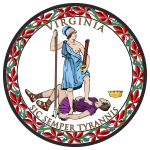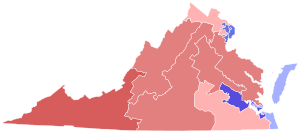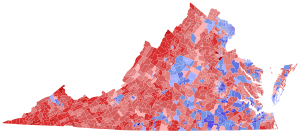| |||||||||||||||||||||
| Turnout | 43.0% | ||||||||||||||||||||
|---|---|---|---|---|---|---|---|---|---|---|---|---|---|---|---|---|---|---|---|---|---|
| |||||||||||||||||||||
McAuliffe: 40–50% 50–60% 60–70% 70–80% 80–90% >90% Cuccinelli: 40–50% 50–60% 60–70% 70–80% 80–90% >90% Tie: 40–50% No votes | |||||||||||||||||||||
| |||||||||||||||||||||
| Elections in Virginia |
|---|
 |
The 2013 Virginia gubernatorial election took place on November 5, 2013, to elect the governor of Virginia. The incumbent governor, Republican Bob McDonnell, was not eligible to run for re-election due to term limits established by the Virginia Constitution. Virginia is the only state that prohibits its governor from serving immediate successive terms. This was the 5th consecutive election in which the Republican nominee was an Attorney General of Virginia.
Three candidates appeared on the ballot for Governor: Republican Ken Cuccinelli, the Attorney General of Virginia; Democrat Terry McAuliffe, a businessman and the former chairman of the Democratic National Committee; and Libertarian Robert Sarvis, a lawyer and businessman.[2]
McAuliffe won the election and was sworn in as governor on January 11, 2014.[3] This was the only Virginia gubernatorial election since 1965 in which no candidate won an outright majority of the vote.[4] This would be the first Virginia gubernatorial election in which that the town of Bedford would become part of Bedford County instead of being an Independent city.[5]
As of 2024, this is the only Virginia gubernatorial election since 1973 in which the elected governor belonged to the same political party of the incumbent U.S. president.[6]
- ^ Virginia Department of Elections (2016). "Registration/Turnout Statistics". The Commonwealth of Virginia. Archived from the original on August 16, 2016. Retrieved July 25, 2016.
- ^ "Official List of Statewide Office Candidates" (PDF). Virginia State Board of Elections. Archived from the original (PDF) on August 13, 2013. Retrieved August 27, 2013.
- ^ Meola, Olympia (November 6, 2013). "McAuliffe edges Cuccinelli to win governor's race". Richmond Times Dispatch. Archived from the original on February 20, 2019. Retrieved November 6, 2013.
- ^ Will Virginia elect its first Governor in nearly 50 years with less than 50% of the vote? Archived October 16, 2013, at the Wayback Machine
- ^ "Bedford reversion to town becomes official today". July 2013.
- ^ "McDonnell wins Virginia governor's race" Archived November 9, 2012, at the Wayback Machine, The Washington Post, November 3, 2009





